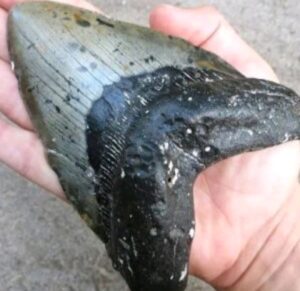9 year old discovered an extremely strange object on the beach

9 year old discovered an extremely strange object on the beach
Beachcombers only ever find common seashells, sea glass, driftwood, and the unusual message in a bottle. However, it might be entertaining to search the sand for something other than a dropped candy wrapper.
When fossils wash up on the shore, they excite beachgoers looking through the sand for more hidden treasures. Fossil collecting is a fascinating activity that combines time outdoors with prehistoric history.
Walk into the water with a sieve and shovel, or even just your bare hands, to hunt for these ancient relics rather than looking for a raptor in Montana’s arid dirt. According to the author, collecting fossils can be easy and inexpensive if you start with preserved shark teeth. They are frequently in abundance on public beaches.
Fossil hunters occasionally find evidence of the massive monsters that formerly swam in the deep waters, yet finger-sized teeth are the most prevalent. The Megalodon was a once-in-a-lifetime discovery.
The name of this extinct mackerel shark, which means “great teeth,” dates back between 23 and 3.6 million years. from the Early Miocene to the Pliocene eras.
Despite being extinct, these dreadful giants’ palm-sized teeth are nevertheless infrequently observed. The teeth, which can grow to be several inches long, will terrify anyone who dives deeper into the water.
In Maryland’s Calvert Beach, incredible fossils that mimic those from the “Jaws” film can be seen. Molly Sampson, age 9, made a once-in-a-lifetime discovery on Christmas Day 2022 while wading in the Chesapeake Bay.
The woman allegedly encountered a gigantic Megalodon tooth while looking for fossils on Christmas morning, according to the Calvert Marine Museum.
The girl’s mother, Alicia Sampson, discussed the fossil with USA TODAY. She responded, “She was beyond happy,” when asked how her daughter was feeling that morning. She had hoped to discover it by accident. She had been scurrying along the shore looking for shark teeth since she was a small child. Molly had already asked for “shark-tooth hunting waders for Christmas” that year. As soon as the waterproof gear arrived, the Sampson family set out to look for shark teeth.
In a Facebook post, the museum stated, “We love seeing and hearing about the gems you find on the shore.” They also mentioned their “First Fossil Friday” program, which helps people like Molly identify fossils. Molly and the rest of the group should have many more wonderful beach days, we hope.
Have you looked for shark teeth before? Please let us know and share this post with your fossil-interested family and friends.

